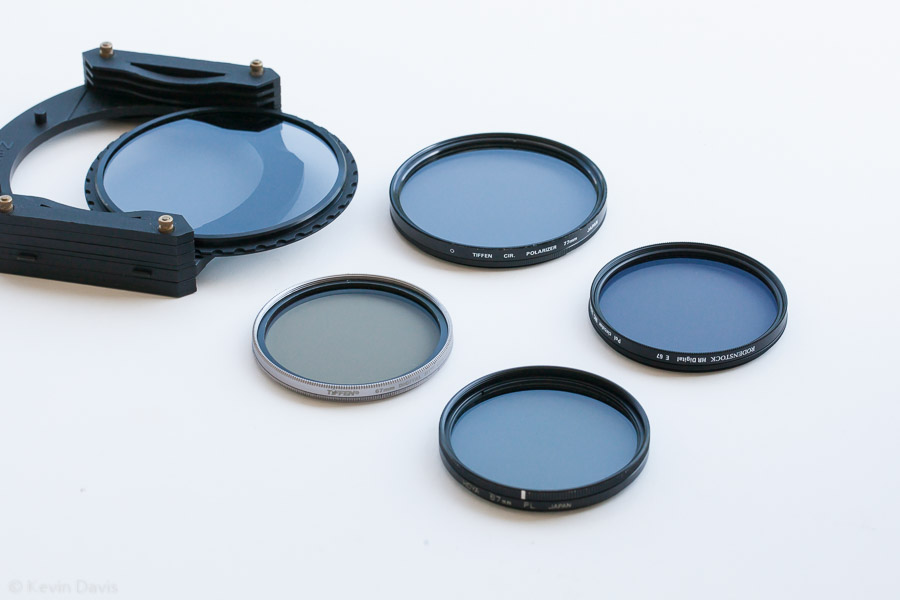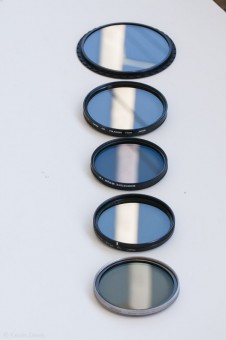
We need polarizing filters and I am not going to explain why. Many other photographer-authors have already done that and I see no need to put my own spin on it. But there may be differences between two polarizing filters, either from two different manufacturers, or from the same manufacturer. That is what we’re going to look at here.
Frankly, choosing a polarizing filter from a dozen or more options is a pain. If you have a limited budget, you might select the cheapest filter. If you have used filters before, you will likely stick with a brand that you know and trust.
The photo above shows five polarizing filters. All attach to the front of a camera lens; four include a screw thread to attach directly to the lens and one is designed for a filter holder. Most are constructed from a glass element and a metal ring, but the most expensive filter is mostly plastic.
Clockwise from top left: (1) Singh-Ray LB Neutral Circular Polarizer for Z-Pro holder, (2) Tiffen circular polarizer 77mm, (3) Rodenstock Digital HR circular polarizer, (4) Hoya polarizer, (5) Tiffen HT Digital circular polarizer.
In true Sesame Street manner … which one of these does not belong with the others? While Singh-Ray does offer standard screw-in filters, this version shown here is designed specifically for a Cokin Z-Pro filter holder. Filter holders such as this allow the use of rectangular graduated filters. If you need both grad filters and polarization, you have two choices: attach a polarizing filter to the lens and then add the filter holder onto that, or use a special filter that fits directly in the holder. The Sing-Ray LB series (LB = lighter and brighter) isn’t quite as dark as most polarizing filters – you lose less light compared to others. And, while some polarizers have a color tint, the LB Neutral does not. This filter is ridiculously expensive.
Next, consider the silver-ring filter, which is a Tiffen Digital HT circular polarizer (HT = High Transmission). Like the Singh-Ray LB, this filter is not as dark as most polarizers, so you lose less light through the filter. Unlike the Sing-Ray LB Neutral, this filter has a color tint. This filter is low-profile; however, while “low profile” usually implies there is no female thread on the front, this filter does have a front thread.
In the specific case of the Digital HT, the front threading and the rear threading are both shallow, allowing the filter to be thinner. But after eight years of use, the rear thread has worn and this filter sometimes does not stay attached to the lens – that’s a problem. I recently replaced this filter with the Rodenstock HR Digital filter. The color is more neutral compared to the Tiffen Digital HT. However, it is not HT or LB, and I do miss that.
What is a low-profile filter? It is simply thinner than usual, in order to solve a particular problem. The problem with adding filters to the front of a lens is that they can cause vignetting, particularly if you stack multiple filters together. Low-profile filters often omit the female thread on the front, meaning you cannot attach another filter in front of it. The thinnest filters I have seen are from Vu Filters (http://www.vufilters.com). Frankly, unless you are experiencing a vignette problem, I suggest avoiding low-profile filters.
In addition to the Tiffen Digital HT, the photo here shows another Tiffen. This is a basic circular polarizing filter. It is good quality and I have relied upon frequently. However, I am replacing it with a B+W F-Pro circular polarizer (not shown), which I think is a bit better.
Just as lenses often have optical coatings on the glass, the same can be true for filters. The second photo (below) shows a telephone pole reflected on the filters. You can see that some filters are less reflective than others, which is achieved through coatings applied to the surface of the glass. From the top of the photo, first is the Singh-Ray, followed by the 77mm Tiffen, and then the 67mm Rodenstock Digital HR. See how the Rodenstock is a bit less reflective than the others? It has multiple coatings on the surface of the glass.
(Click on the image below to view it larger size.)

The one polarizing filter that I have not yet mentioned is an old Hoya filter, which is a linear polarizer, not a circular polarizer. Any linear polarizer can interfere with electronic auto-focus. Circular is generally preferable because you can always use a circular polarizer in place of a linear polarizer, but the reverse is not true. None-the-less, I did use this filter quite recently in a situation where I was relying upon manual focus. I have owned this filter for twenty years … since before I owned autofocus lenses.
Once upon a time, photographers needed an array of color-correction filters to compensate for peculiarities in the light. However, with the advent of digital cameras that include a color temperature adjustment, color correction can be done in-camera, largely eliminating the need for such filters. So, today, I carry only three types of filters, polarizing, neutral density, and graduated neutral density. While ND and grad ND are rather specialized devices that many folks do not need, the one filter every outdoor photographer needs is a polarizing filter.